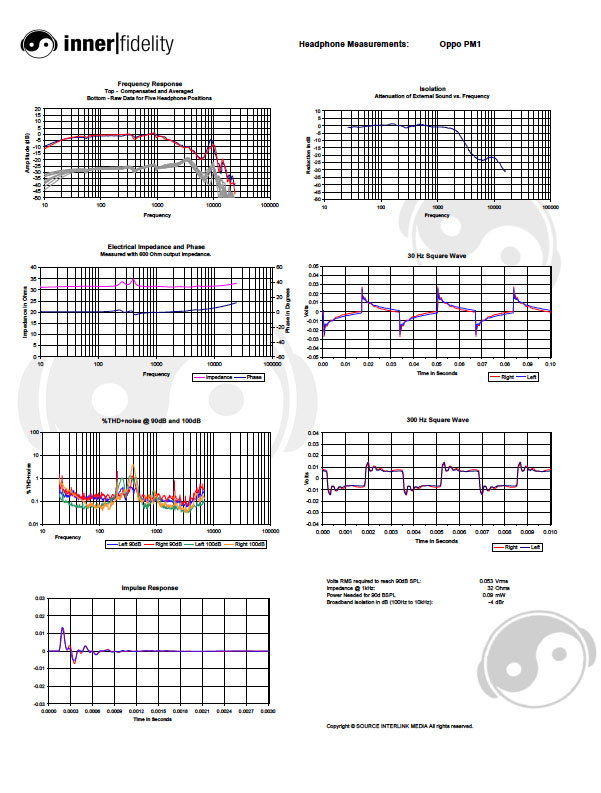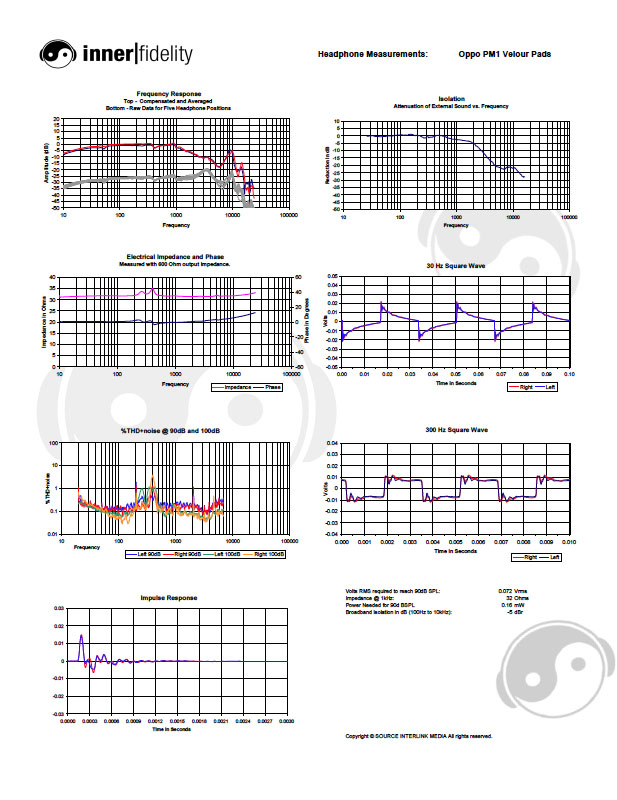| Columns Retired Columns & Blogs |
The Scrumptious Oppo Digital PM-1 Planar Magnetic Headphone Measurements
Click on graphs image to download .pdf for closer inspection.
Click on graphs image to download .pdf for closer inspection.
Charts for the PM-1 with both velour and leather pads are shown above. Aside from the slightly less reliable seal of the leather pads (as seen in the variations in the raw FR plot) and the very slightly brighter sound of the leather pads (as seen in the slightly raised leading edge of the 300Hz square wave) the two sets of measurements are quite similar and I'll adress the measurements as a whole.
Again, raw FR plots show the velour earpads seal more reliably than the leather pads, but even with the leather pads the lack of seal only shows up below about 30Hz. This seems to me fairly good evidence that the "leaky seal" design of the pads works fairly well. Otherwise, bass does begin to roll-off at 60Hz, but is only down about 4dB at 20Hz. This response is quite similar to Audeze recent offerings, which I find to be a bit bass light and wanting something more like the +2dB below 120Hz of the preliminary Harman target response curve.
Compensated response is ruler flat between 70Hz and 1kHz other than a small dip at 400Hz that coincides with one of the driver resonances as seen in the impedance plot. Ideal a headphone should measure flat to 2kHz on the compensated plot prior to rolling-off. Ideally, the dip between 3.5kHz and 10kHz on the raw FR plot should be filled in and the entire response 2kHz and above lifted 3-5dB. I'm not sure if I'd like the sound of them as much at that point, but it would be more neutral I think.
30Hz square wave shows a moderate sway-back matching the roll-off in FR below 60Hz, and the listening observations of a slight lack of extension into the lowest octave. But very low measured THD+noise in the lower registers indicate good bass quality matching the punchy, dynamic character heard in listening.
300Hz square wave should over-shoot a little bit, in my opinion, and the PM-1 stops short giving it the very polite character heard in listening. THe leather pads apear to help in this regard. Also seen is a double blip I've seen quite often in other planar magnetic headphones. Generally I've experienced this feature as a lack of imaging due to unclean edges obscuring timing information at the ears. I did experience the PM-1 as having poor imaging and a slightly hazy character in its mid-treble articulations. Though it's worthy to note that the 300Hz square wave and impulse response are fairly noise-free.
To my mind the most interesting measurements on these sheets are the THD+noise and impedance plot. As was discussed in the body of the review, the PM-1 diaphragm has two resonances: one for the diaphragm as a whole, and one where frequency narrows the active area of the diaphragm within the corrugations and a second resonance occurs. These resonances can clearly be seem in the impedance plot as peaks at 250Hz and 400Hz. Distortion also rises at these frequencies, but remains below an acceptable 1%. Igor Levitsky claims increased distortion is strongly even order and likely pleasing. I found the midrange euphonic and vacuum tube-like, which I liked very much. But when running off the Teton tube amp it was too syrupy. This is a headphone that should be driven by a low-output impedance amp.
The PM-1 is an open headphone but does off some modest isolation above 1kHz. I would consider this a poor headphone to purchase for traveling duties. Around the home or office and quiet places outdoors they'll be fine. At 32 Ohms and 72mVrms needed to achieve 90dBspl at the ear, the PM-1 is well suited to use with portable devices and will achieve solid listening levels.
- Log in or register to post comments






































